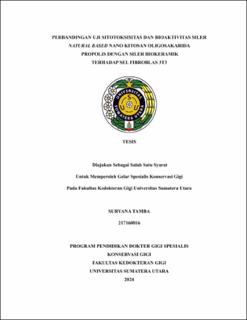| dc.description.abstract | Introduction: Currently, there is no ideal endodontic sealer. Bioceramic sealers with calcium silicate-based are known for their high biocompatibility, can adhere to root canal walls, and potential to induce osteogenic responses, categorizing them as biomimetic materials. However, bioceramic sealers also have shortcomings in their physical properties. Chitosan oligosaccharide (COS) is an oligomer of β–(1→4)-linked D-glucosamine, has a low molecular weight and higher solubility and low viscosity. It has advantages as an antioxidant and antibacterial agent, as well as a role in lesion healing and tissue regeneration. Additionally, COS can improve the physical properties of cement. Propolis contains various bioactive components, including flavonoids, phenolic acids, and terpenes, which have antibacterial and antioxidant effects. The development of these two natural-based materials can create a new root canal sealer with good biocompatibility and bioactivity. The objective of this study is to determine the comparison of cytotoxicity and bioactivity tests of nano chitosan oligosaccharide-propolis sealer with Ceraseal® bioceramic sealer.
Materials and Methods: Nano chitosan propolis sealer is a semi-solid (paste) material composed of nano chitosan oligosaccharide combined with nano propolis, formulated with 41.25% calcium silicate, 35.8% chitosan oligosaccharide, 2.9% propolis, and 20% zirconium oxide. The calcium silicate-based bioceramic sealer used in this study is Ceraseal®. Both sealer formulations underwent cytotoxicity testing using the MTT assay and bioactivity testing using Alizarin Red Staining (ARS) on fibroblast cells. The obtained data were subjected to One-way ANOVA statistical analysis, followed by post hoc LSD test.
Results: Both sealer groups were found to be non-toxic to fibroblast cells. There was a significant difference in cytotoxicity values between the nano chitosan oligosaccharide-propolis sealer and the Ceraseal® bioceramic sealer. Additionally, the bioactivity of the nano chitosan-propolis sealer was relatively higher compared to that of the Ceraseal® bioceramic sealer.
Conclusion : Nano chitosan oligosaccharide-propolis sealer has the potential to provide good clinical implications, demonstrating non-cytotoxicity and superior bioactivity compared to the Ceraseal® bioceramic sealer. | en_US |


